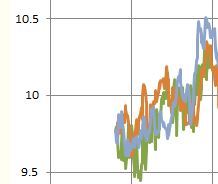GregLocock
Automotive
This is a bit of a roundabout question.
So, if you have a short series of samples, say 135, could you determine whether there is a linear signal buried in the noise? Imagine that the series is a random walk ie value = value(n-1)+ a signed random variable + X. The signed random variable is of the order of +/- 0.5 say +/- 3 sigma limits. X might be .01
= value(n-1)+ a signed random variable + X. The signed random variable is of the order of +/- 0.5 say +/- 3 sigma limits. X might be .01
Apparently the answer is no, but I wondered if a technique that measured how many attempts /on average/ it took to find a random number sequence that sufficiently matched the 135 long record for a given assumed value of X was (a) known or (b) a plausible way of investigating the best value of X? Or even graph the average number of tries to meet an RMS error value vs X?
You may know the background to this question or you may not. I'll reveal all later
Here's a plot, the green curve is real world data, the other two are random walks. One of the random walks is just random, the other has a gradient superimposed on it. I am looking for a way of reliably assessing whether there is a linear trend underneath the random walk.

Cheers
Greg Locock
New here? Try reading these, they might help FAQ731-376
So, if you have a short series of samples, say 135, could you determine whether there is a linear signal buried in the noise? Imagine that the series is a random walk ie value
Apparently the answer is no, but I wondered if a technique that measured how many attempts /on average/ it took to find a random number sequence that sufficiently matched the 135 long record for a given assumed value of X was (a) known or (b) a plausible way of investigating the best value of X? Or even graph the average number of tries to meet an RMS error value vs X?
You may know the background to this question or you may not. I'll reveal all later
Here's a plot, the green curve is real world data, the other two are random walks. One of the random walks is just random, the other has a gradient superimposed on it. I am looking for a way of reliably assessing whether there is a linear trend underneath the random walk.

Cheers
Greg Locock
New here? Try reading these, they might help FAQ731-376
